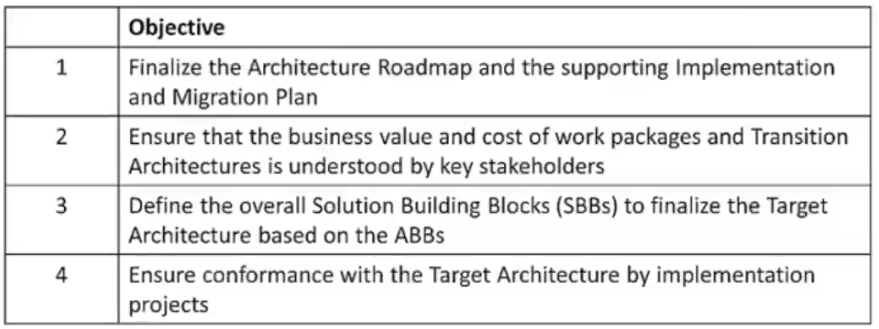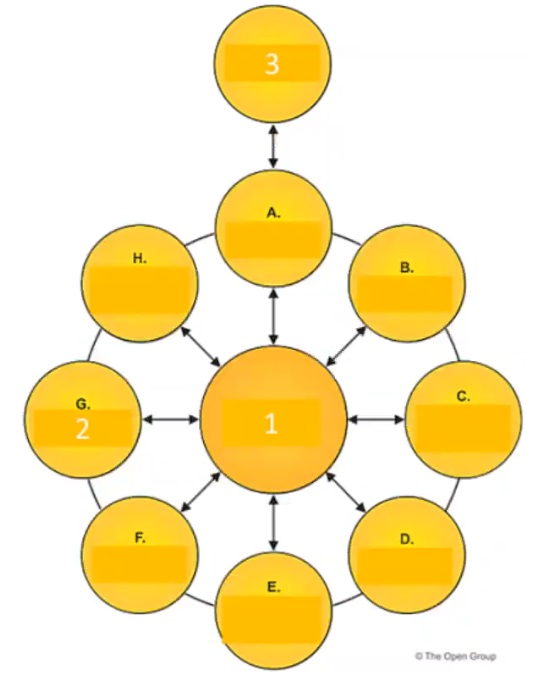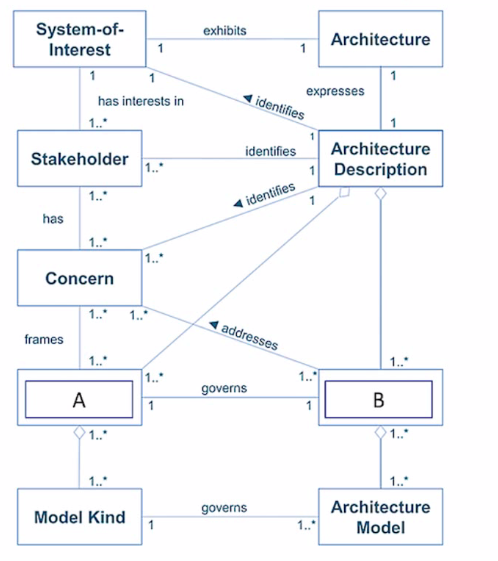Question # 1
| Which section of the TOGAF template for Architecture Principles should describe the
relationship to other principles? | | A. Name | | B. Rationale | | C. Statement | | D. Implications |
B. Rationale
Explanation:
According to the TOGAF template for Architecture Principles, the Rationale section should
describe the relationship to other principles, as well as the business benefits and the
intentions of adhering to the principle. The Rationale section should use business
terminology and point to the similarity of information and technology principles to the
principles governing business operations. The Rationale section should also explain how
the principle supports the achievement of the business objectives and key architecture
drivers.
Question # 2
| Complete the sentence The purpose of Enterprise Architecture is to_______________. | | A. take major improvement decisions | | B. control the bigger changes | | C. guide effective change | | D. govern the stakeholders |
C. guide effective change
Explanation:
The purpose of Enterprise Architecture is to guide effective change by providing a coherent and consistent view of the enterprise’s current and future state, as well as the roadmap and principles for achieving it. Enterprise Architecture helps to align business and IT strategies, optimize resources and investments, reduce complexity and risks, enhance agility and innovation, and deliver value to stakeholders. Reference: The TOGAF® Standard | The Open Group Website, Section 1.3 Executive Overview.
Question # 3
Consider the following ADM phases objectives.

Which phase does each objective match? | | A. 1F-2G-3F-4F
| | B. 1E-2F-3E-4G
| | C. 1G-2E-3F-4E
| | D. 1F-2F-3E-4G |
B. 1E-2F-3E-4G
Explanation: 1E: To identify delivery vehicles (projects programs portfolios) that will deliver
the Target Architecture 2F: To confirm readiness and ability to undergo change 3E: To
determine whether an incremental approach is required and if so identify Transition
Architectures that will deliver continuous business value 4G: To perform appropriate
governance functions while the solution is being implemented.
Question # 4
| Which of the following supports the need to govern Enterprise Architecture? | | A. The Architecture Project mandates the governance of the target architecture
| | B. The TOGAF standard cannot be used without executive governance
| | C. Best practice governance enables the organization to control value realization
| | D. The Stakeholders preferences may go beyond the architecture project scope and needs
control |
C. Best practice governance enables the organization to control value realization
Explanation: This statement best supports the need to govern Enterprise Architecture.
Best practice governance enables the organization to control value realization by ensuring
that architectures are aligned with the enterprise’s strategy and objectives, meet the quality
and performance requirements, and deliver the expected benefits and outcomes. The
Architecture Project does not mandate the governance of the target architecture, but rather
follows the governance framework established by the enterprise. The TOGAF standard can
be used without executive governance, but it is recommended that executive sponsorship
and support are obtained for successful architecture development and transition. The
Stakeholders preferences may go beyond the architecture project scope and need control,
but this is not the primary reason for governing Enterprise Architecture.
Question # 5
| What is an objective of the ADM Implementation Governance Phase? | | A. To provide continual monitoring of the governance framework
| | B. To ensure conformance for the target architecture
| | C. To finalize the Implementation and Migration Plan
| | D. To establish the resources for architecture governance |
B. To ensure conformance for the target architecture
Explanation: The objective of the ADM Implementation Governance Phase is to provide
an architectural oversight of the implementation and to ensure conformance for the target architecture. This phase involves establishing procedures and processes to monitor and
control the implementation projects and to verify that they comply with the defined
architecture.
Question # 6
Exhibit:

Consider the illustration showing an architecture development cycle Which description
matches the phase of the ADM labeled as item 1? | | A. Conducts implementation planning for the architecture defined in previous phases
| | B. Provides architectural oversight for the implementation
| | C. Operates the process of managing architecture requirements
| | D. Establishes procedures for managing change to the new architecture |
C. Operates the process of managing architecture requirements
Explanation:-
The illustration shows an architecture development cycle based on the TOGAF
ADM (Architecture Development Method), which is a method for developing and
managing an enterprise architecture1.
-
The ADM consists of nine phases, each with a specific purpose and output. The
phases are1:
-
In addition to these phases, there is a central process called Requirements
Management, which is labeled as item 1 in the illustration. This process operates
throughout the ADM cycle, and its purpose is to manage the architecture
requirements throughout the architecture development, ensuring that they are
aligned with the business requirements and the stakeholder concerns2.
-
Therefore, the description that matches the phase of the ADM labeled as item 1 is
C. Operates the process of managing architecture requirements.
Question # 7

Consider the image showing basic architectural concepts.
What are items A and B? | | A. A-Architecture Viewpoint, B-Architecture View
| | B. A-Architecture Board, B-Architecture Capability
| | C. A-Candidate Architecture, B-Trade-off
| | D. A-Requirement. B-Candidate Architecture |
A. A-Architecture Viewpoint, B-Architecture View
Explanation:-
The image shows a diagram that illustrates the basic concepts of architecture
description as defined by the ISO/IEC/IEEE 42010:2011 standard1, which is also
adopted by the TOGAF standard2.
-
According to the ISO/IEC/IEEE 42010:2011 standard, an architecture description
is a work product used to express an architecture, and it consists of one or more
architecture views1.
-
An architecture view is a representation of a system from the perspective of a
related set of concerns, and it conforms to an architecture viewpoint1.
-
An architecture viewpoint is a specification of the conventions for constructing and
using an architecture view to address specific stakeholder concerns1.
-
Therefore, the correct answer is option A, which identifies the items labeled as “A”
and “B” in the image as an architecture viewpoint and an architecture view,
respectively.
The Open Group OGEA-103 Exam Dumps
5 out of 5
Pass Your TOGAF Enterprise Architecture Combined Part 1 and Part 2 Exam in First Attempt With OGEA-103 Exam Dumps. Real Enterprise Architecture Exam Questions As in Actual Exam!
— 114 Questions With Valid Answers
— Updation Date : 28-Mar-2025
— Free OGEA-103 Updates for 90 Days
— 98% TOGAF Enterprise Architecture Combined Part 1 and Part 2 Exam Passing Rate
PDF Only Price 49.99$
19.99$
Buy PDF
Speciality
Additional Information
Testimonials
Related Exams
- Number 1 The Open Group Enterprise Architecture study material online
- Regular OGEA-103 dumps updates for free.
- TOGAF Enterprise Architecture Combined Part 1 and Part 2 Practice exam questions with their answers and explaination.
- Our commitment to your success continues through your exam with 24/7 support.
- Free OGEA-103 exam dumps updates for 90 days
- 97% more cost effective than traditional training
- TOGAF Enterprise Architecture Combined Part 1 and Part 2 Practice test to boost your knowledge
- 100% correct Enterprise Architecture questions answers compiled by senior IT professionals
The Open Group OGEA-103 Braindumps
Realbraindumps.com is providing Enterprise Architecture OGEA-103 braindumps which are accurate and of high-quality verified by the team of experts. The The Open Group OGEA-103 dumps are comprised of TOGAF Enterprise Architecture Combined Part 1 and Part 2 questions answers available in printable PDF files and online practice test formats. Our best recommended and an economical package is Enterprise Architecture PDF file + test engine discount package along with 3 months free updates of OGEA-103 exam questions. We have compiled Enterprise Architecture exam dumps question answers pdf file for you so that you can easily prepare for your exam. Our The Open Group braindumps will help you in exam. Obtaining valuable professional The Open Group Enterprise Architecture certifications with OGEA-103 exam questions answers will always be beneficial to IT professionals by enhancing their knowledge and boosting their career.
Yes, really its not as tougher as before. Websites like Realbraindumps.com are playing a significant role to make this possible in this competitive world to pass exams with help of Enterprise Architecture OGEA-103 dumps questions. We are here to encourage your ambition and helping you in all possible ways. Our excellent and incomparable The Open Group TOGAF Enterprise Architecture Combined Part 1 and Part 2 exam questions answers study material will help you to get through your certification OGEA-103 exam braindumps in the first attempt.
Pass Exam With The Open Group Enterprise Architecture Dumps. We at Realbraindumps are committed to provide you TOGAF Enterprise Architecture Combined Part 1 and Part 2 braindumps questions answers online. We recommend you to prepare from our study material and boost your knowledge. You can also get discount on our The Open Group OGEA-103 dumps. Just talk with our support representatives and ask for special discount on Enterprise Architecture exam braindumps. We have latest OGEA-103 exam dumps having all The Open Group TOGAF Enterprise Architecture Combined Part 1 and Part 2 dumps questions written to the highest standards of technical accuracy and can be instantly downloaded and accessed by the candidates when once purchased. Practicing Online Enterprise Architecture OGEA-103 braindumps will help you to get wholly prepared and familiar with the real exam condition. Free Enterprise Architecture exam braindumps demos are available for your satisfaction before purchase order. The Open Group OGEA-103 exam, also known as the TOGAF
Enterprise Architecture Combined Part 1 and Part 2 exam, is designed for individuals
aiming to become certified TOGAF Enterprise Architecture Practitioners. This
certification is highly regarded in the enterprise architecture community,
providing a comprehensive understanding of TOGAF
principles and practices.
Exam Key Topics
The OGEA-103 exam covers a wide range of topics essential
for enterprise architects. The key areas include:
- TOGAF
Framework and Methodology: Understanding the TOGAF Architecture
Development Method (ADM) and its phases.
- Enterprise
Continuum and Tools: Knowledge of how to utilize the Enterprise
Continuum, including architecture partitions and repository.
- Architecture
Governance: Insight into the governance frameworks and their
application within enterprise architecture.
- Architecture
Views and Viewpoints: Proficiency in using TOGAF views and viewpoints
for different stakeholder needs.
- Building
Blocks: Identifying and defining reusable architecture building
blocks.
- ADM
Techniques: Familiarity with various techniques such as stakeholder
management, business transformation readiness, and risk management.
Technical Information About the Exam
The OGEA-103 exam consists of two parts:
- Part
1: This section includes 40 multiple-choice questions, focusing on the
foundational knowledge of TOGAF.
It is a closed-book exam with a passing score of 60%.
- Part
2: This section comprises 8 complex scenario-based questions, which
are open book. The scenarios test the candidates ability to apply TOGAF
concepts in practical situations. The passing score for this part is also
60%.
The exam duration is 150 minutes, with 60 minutes allocated
for Part 1 and 90 minutes for Part 2. The test can be taken at authorized
centers or online with a proctor.
How RealBraindumps is Helpful?
RealBraindumps is an invaluable resource for those preparing
for the OGEA-103 exam. It provides:
- Comprehensive
Study Guides: Detailed OGEA-103 materials that cover all exam topics
systematically.
- Practice
Exams: Realistic OGEA-103 Exam Questions that mirror the format and difficulty of the actual
exam, helping candidates to gauge their preparedness.
- Updated
Content: Regular updates to ensure that the OGEA-103 study materials
reflect the latest TOGAF standards and exam formats.
- User
Community: A supportive community where candidates can share
experiences, tips, and resources to enhance their study process.
Conclusion
Achieving the TOGAF Enterprise Architecture
Practitioner certification through the OGEA-103 exam is a significant milestone
for enterprise architects. By mastering the key topics and utilizing resources
like RealBraindumps.com,
candidates can confidently prepare for and succeed in the exam, advancing their
careers and contributing to their organizations architectural success.
Send us mail if you want to check The Open Group OGEA-103 TOGAF Enterprise Architecture Combined Part 1 and Part 2 DEMO before your purchase and our support team will send you in email.
If you don't find your dumps here then you can request what you need and we shall provide it to you.
Bulk Packages
$50
- Get 3 Exams PDF
- Get $33 Discount
- Mention Exam Codes in Payment Description.
Buy 3 Exams PDF
$70
- Get 5 Exams PDF
- Get $65 Discount
- Mention Exam Codes in Payment Description.
Buy 5 Exams PDF
$100
- Get 5 Exams PDF + Test Engine
- Get $105 Discount
- Mention Exam Codes in Payment Description.
Buy 5 Exams PDF + Engine
 Jessica Doe
Enterprise Architecture
We are providing The Open Group OGEA-103 Braindumps with practice exam question answers. These will help you to prepare your TOGAF Enterprise Architecture Combined Part 1 and Part 2 exam. Buy Enterprise Architecture OGEA-103 dumps and boost your knowledge.
FAQs of OGEA-103 Exam
What
is the OGEA-103 exam?
The
OGEA-103 exam is the TOGAF Enterprise Architecture Combined Part 1 and Part 2
exam. It consists of two sections: Part 1 with 40 simple multiple-choice questions,
and Part 2 with 8 complex scenario questions. The exam duration is 2 hours and
30 minutes, and candidates must pass both sections to achieve certification.
What
are the prerequisites for taking the OGEA-103 exam?
There
are no formal prerequisites for taking the OGEA-103 exam. However, it is
recommended that candidates have a good understanding of the TOGAF framework
and have completed relevant training or self-study.
How
is the OGEA-103 exam scored?
The
Part 1 section of the OGEA-103 exam is scored based on the number of correct
answers, with a pass mark of 60% (24 out of 40 questions). The Part 2 section
uses gradient scoring for scenario-based questions, with a pass mark of 60% (24
out of 40 points).
Where
can I take the OGEA-103 exam?
The
OGEA-103 exam can be taken at Pearson VUE test centers worldwide or through
online proctoring via Pearson VUE's OnVUE platform. You can schedule your exam
through The Open
Group’s certification website.
How
much does the OGEA-103 exam cost?
The
cost of the OGEA-103 exam varies by region and testing method. It is best to
check the latest pricing directly on The Open Group's certification website or
through Pearson VUE when booking the exam.
What
job roles can I pursue with the TOGAF OGEA-103 certification?
With
the TOGAF OGEA-103 certification, you can pursue roles such as Enterprise
Architect, Solution Architect, Business Architect, IT Architect, and IT
Strategy Consultant. These roles are critical in aligning IT strategy with
business goals.
What
is the average salary for a professional with the TOGAF OGEA-103 certification?
Salaries
for TOGAF-certified professionals vary widely based on location, experience,
and specific job role. However, Enterprise Architects with TOGAF certification
often earn between $100,000 to $150,000 annually in the United States.
What
are the long-term career benefits of obtaining the TOGAF OGEA-103
certification?
The
TOGAF OGEA-103 certification enhances your credibility and expertise in
enterprise architecture, opens up advanced career opportunities, and is
recognized globally. It also provides a solid foundation for further
specialization within IT architecture and strategy.
How
does the TOGAF OGEA-103 certification impact job marketability?
Having
the TOGAF OGEA-103 certification significantly improves your job marketability
by validating your knowledge and skills in enterprise architecture. Employers
often seek TOGAF-certified
professionals for their ability to optimize IT and business alignment.
Are
there any continuing education requirements for maintaining the TOGAF OGEA-103
certification?
There
are no specific continuing education requirements to maintain the TOGAF
OGEA-103 certification. However, staying updated with the latest TOGAF
standards and participating in relevant professional development activities is
beneficial.
What
topics are covered in the OGEA-103 exam?
The
OGEA-103 exam covers topics such as the TOGAF framework, architecture
development method (ADM), enterprise continuum, architecture governance, and
TOGAF content framework. It assesses both foundational knowledge and practical
application through scenarios.
Is
the OGEA-103 exam open book?
The
Part 2 section of the OGEA-103 exam is open book, meaning candidates can refer
to the TOGAF standard during the exam. The Part 1 section is closed book.
What
study materials are recommended for the OGEA-103 exam?
Recommended
study materials include the TOGAF Standard, 10th Edition, official training
courses provided by The Open Group, and study guides available from RealBraindumps website.
How
can I prepare for the scenario-based questions in Part 2 of the OGEA-103 exam?
To
prepare for scenario-based questions, it is important to thoroughly understand
the TOGAF framework and practice applying its principles to real-world
situations. Case studies and practical exercises from official
training courses can be particularly helpful.
What are The Open Group OGEA-103 Learning
Materials and why are they important for exam preparation?
The
Open Group OGEA-103 Learning Materials refer to comprehensive resources such as
lecture notes, practice questions, and exam readiness packs designed
specifically to help candidates prepare for the OGEA-103 exam.
How can RealBraindumps assist in preparing for
The Open Group OGEA-103 Exam?
RealBraindumps
offers a range of study materials including The Open Group
OGEA-103 Practice Questions, which simulate real exam scenarios to enhance
preparation effectiveness.
Why should I trust RealBraindumps for The Open
Group OGEA-103 Exam Prep?
RealBraindumps
provides verified and up-to-date OGEA-103 Learning Materials, ensuring accuracy
and relevancy in line with The Open Group's exam requirements, thereby boosting
your confidence and readiness.
What advantages do The Open Group OGEA-103
Lecture Notes from RealBraindumps offer over other study materials?
The
Open Group OGEA-103 Lecture Notes from RealBraindumps are meticulously curated
by experts to cover all exam topics comprehensively, facilitating a deeper
understanding and retention of key concepts needed to excel in the exam.
How can The Open Group OGEA-103 Question Banks
from RealBraindumps help in assessing my exam readiness?
The
Open Group OGEA-103 Question Banks on RealBraindumps
are designed with diverse question types and difficulty levels, allowing
candidates to assess their strengths and areas needing improvement, thereby
optimizing their exam preparation strategy.
|
